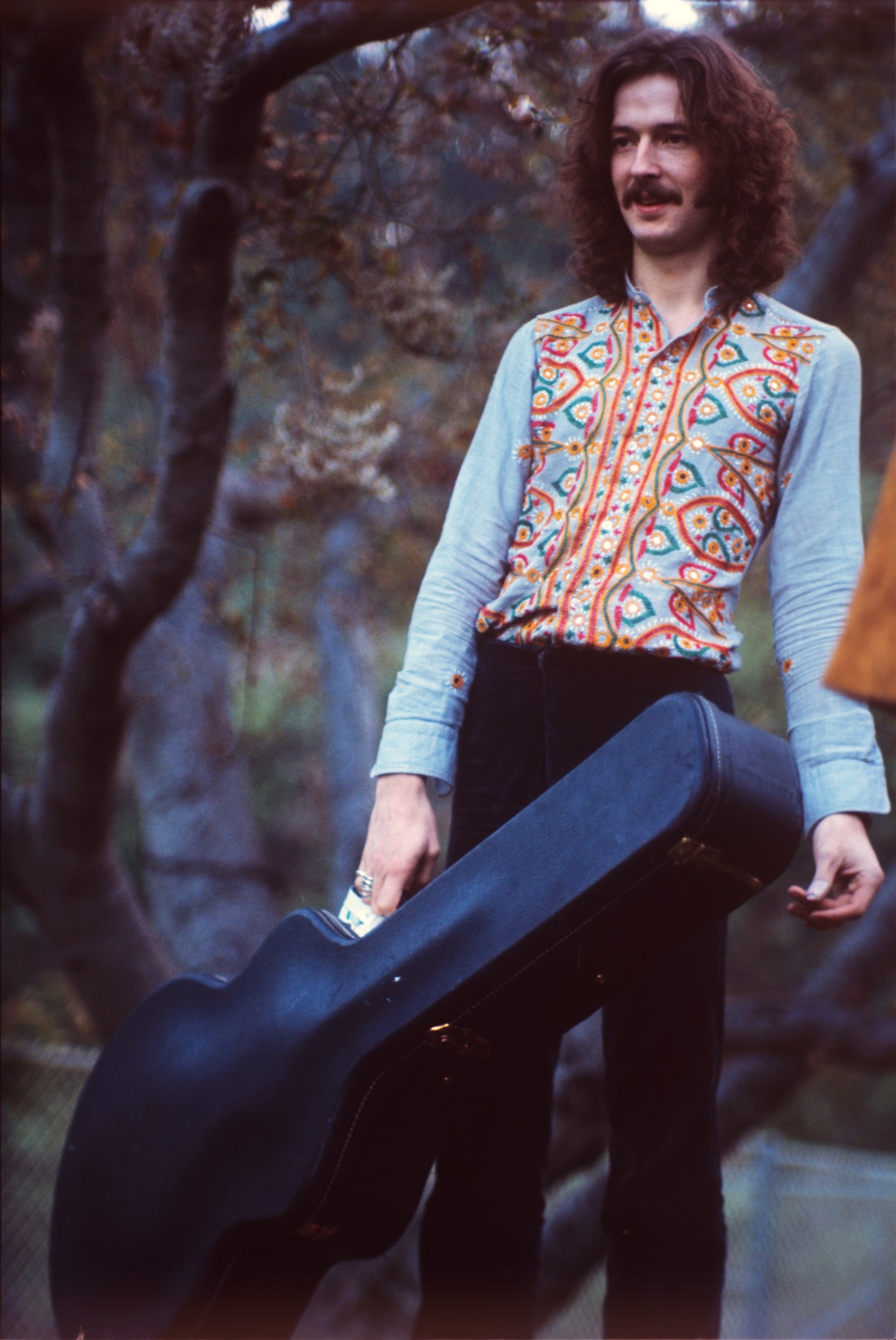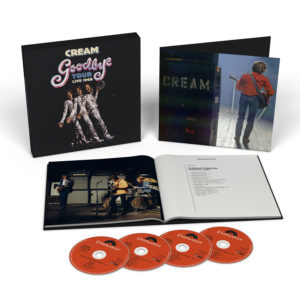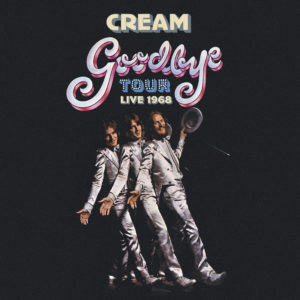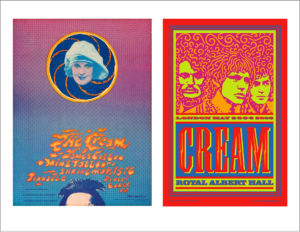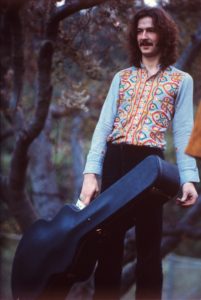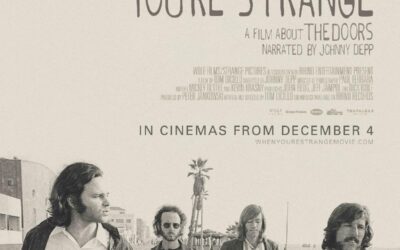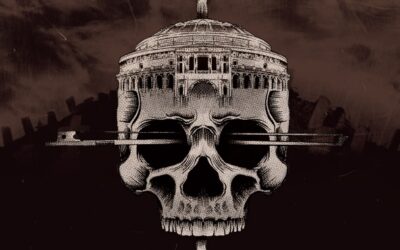4CD Live Box Set
BY HARVEY KUBERNIK © 2020
“Cream was a shambling circus of diverse personalities who happened to find that catalyst together….. any one of us could have played
unaccompanied for a good length of time. So you put the three of us together in front of an audience willing to dig it limitles
sly, we could have gone on forever…. And we did….just going for the moon every time we played.”–Eric Clapton
The Universal Music Enterprises record label in March 2020 will release the 4-CD, special edition of Cream’s Goodbye Tour Live 1968. The collection assembles 36 tracks, including 29 making their first appearance on CD, recorded during Cream’s farewell tour of the US in October 1968 and their final UK date at London’s Royal Albert Hall on November 26th of that same year.
There are a total of 19 previously unissued tracks, and a further 10 selections from the Royal Albert Hall show, which have only ever been available on DVD.
On its original release in February 1969, Goodbye, which combined live performances from their last tour dates with a handful of studio recordings, earned a UK No. 1 slot and achieved a No. 2 position on the US Billboard chart.
This new expanded edition comprises three US concerts; Oakland Coliseum, Los Angeles Forum, San Diego Sports Arena alongside London’s Royal Albert Hall.
The Oakland Coliseum, Los Angeles Forum and San Diego Sports Arena concerts were mastered from the original 1968 analog mix reels by Kevin Reeves at Universal Mastering, Nashville, TN. The Royal Albert Hall concert was mastered from the original 1968 analog transfer reels by Jason NeSmith at Chase Park Transduction, Athens, GA.
Cream members Ginger Baker (drummer), Jack Bruce (bass), and Eric Clapton (guitar), set the template for not only the ‘super group’ but also the ‘power trio,’ with their innate musical talent. As a live attraction, Cream debuted in August 1966, and then shone briefly but brightly throughout two trailblazing years.
On December 21, 2019, I discussed Cream’s sonic legacy with Dr. Robert Klapper on his ESPNLA Weekend Warrior radio program. http://www.espn.com/espnradio/losangeles/play?id=28345883
Eric Clapton had arrived into Cream via the Yardbirds and John Mayall’s Bluesbreakers, Jack Bruce and Ginger Baker had been the rhythm section for the Graham Bond Organization. Initially the darlings of nascent FM radio in early 1967, the outfit’s vinyl offerings soon dominated play lists on the AM dial as well in 1967.
Cream, like the Jimi Hendrix Experience, spearheaded formations of rock trio bands globally, and their 1968 hit record influenced a recording session by the Doors.
“Cream’s ‘Sunshine Of Your Love’ was out and we’re in the studio, trying to play ‘Hello, I Love You,’ Doors’ drummer John Densmore reminisced to me in a 2007 interview. “We’re in the studio, and Robby says, ‘Why don’t you try and do that Cream beat where [Ginger] Baker sort of turns it around?’ And I did.
“Two bars of Ginger Baker is in ‘Hello, I Love You.’ (laughs). Ginger was in a trio with a lot of poly rhythm shit goin’ on. Like Elvin [Jones]. Charlie Watts’s feel. Ginger had the pocket. He got it from hearing all those jazz guys like Stan Levy and Chico Hamilton.”
Cream’s Wheels of Fire dominated the AM and FM radio dials during 1968. The double pocket LP housed studio sides and live dates. The recording engineers on disc one were Tom Dowd and Adrian Barber of Atlantic/ATCO Records. The live performances on disc two were recorded in San Francisco by Bill Halverson and the Wally Heider mobile truck, mixed by Adrian Barber.
During 2007 I interviewed sound engineer Bill Halverson. His impressive resume credits list the Beach Boys’ Wild Honey, and Live in 3 and 2/3/4 Time by Don Ellis. Halverson is a veteran of the 1967 Monterey International Pop Festival. That assignment prepared him for 1968 live tapings of Cream, Johnny Cash, Janis Joplin, Jefferson Airplane, and Chuck Berry with the Steve Miller Blues Band.
“Wally asked me to come to the Monterey International Pop Festival as sort of his second engineer. In 1966 we did the Otis Redding Live at The Whisky album. I had been a horn player and Wally let me mix the horns through an Ampex mixer. We also set up the stuff for the Beatles at the Hollywood Bowl in 1965. The Capitol engineers came in and got in the truck but we set it up. We brought the truck in. I had been around some noise,” volunteered Halverson.
“I was a big band guy and a vocal group guy who was in love with the Four Freshman and Hi-Lo’s, which really served me on the Beach Boys and helping me set up for Crosby, Stills and Nash.
“At the Monterey International Pop Festival we used 4-track and the original console that he had in the mobile truck. When I first met Wally Heider it was in the trunk of his Cadillac with a trailer in the back, and he had this old Dodge red truck. It was a 12 position Universal Audio Bill Putnam built console. By the time we did Cream Wheels of Fire live it was UA parts, 12 position, but Frank De Madeo put it together and it was a 4 track board.
“I got lucky when doing the Monterey live recording and Chuck Berry live just before. Heider had some 5 46 Shure microphones, same mic as an SM 57. He had those because they were cheap. I used them on Chuck with Steve Miller as the backing band and it was the only time at the Fillmore that we sat up in the club in the dressing room.
“Wally always used Scotch tape. He would use the 201 tape in the recording but the 203 was the one that had 45 minutes on a reel because he would always stagger the machines so you could play for two hours and not miss anything. Scotch tape at 15 ips through a Frank De Medeo designed Bill Putnam components tube console.
“The thing was that Shure made a wind screen that wasn’t very good. There are some of those on some of the vocal mikes at Monterey but when we later did Johnny Cash Live At Folsom Prison we used a black foam one.
“At the time I was not too fond of the new psychedelic music yet, either. And the thing that really changed me was doing Cream because that was a jazz band. In reality, it is a rock ‘n’ roll band but for me at that time it sounded like a jazz band just ‘cause of all the free form stuff.
“Tom Dowd showed up and I thought he was gonna engineer it. And we set up for up for the sound check and they had had a real struggle with everything distorting when they tried to record them in England and New York. [Abe Jacob also assisted Wally Heider on the Cream recording].
“When I first opened up the mike on the amps it was distorting. And I finally found this place by accident in between the four speakers of a Marshall stack where it was just up against the grill cloth. And it was clean. And the side benefit when we played it back was that Eric’s guitar sounded like it was in a separate room, ‘cause the four speakers like acted like a baffle.
“Ginger Baker reminded me of a real good jazz drummer. He had two kick drums and all those cymbals and toms. Heider had a way of just putting a couple of Sony C-37 tube overhead and a couple of 5 46 on snare and hi hat and kicks. Heider also had this pair of Neumann 67 tube microphones that he had a knack for placing them for audience mikes but keeping them out of the way of the PA and doing that. I used those same 67’s at Fillmore and everywhere for audience.
“I later did the Cream ‘Badge’ session at Heider’s studio 3 in Hollywood with (George) Harrison and (Eric) Clapton and Jack Bruce.
“So I had some real good history with Atlantic,” reinforced Halverson. “I had done to this point a lot of sessions but not a full album. So, I asked the person at the booking office if I could put my name on the upcoming Crosby, Still and Nash album and they said they’d get back to me. And they said ‘OK.’ I had no idea Crosby and Stills were at Monterey earlier. I was focused on the sessions and equipment.
“I later got the mix job with Delaney Bonnie & Friends with Eric and Harrison, which got me the one day gig of doing ‘Teasin’’ with King Curtis and Eric, which got me engineering the first Clapton solo record.”
Future Sirius XM satellite radio deejay Rodney Bingenheimer attended the fabled “Badge” session with fashion designer Jeannie Franklyn, [aka Genie the Tailor], who also wrote a monthly column for Tiger Beat magazine. She owned a boutique in Hollywood and was a light in the Sunset Strip underground community.
“That ‘Badge’ basic track session was an amazing hang,” Bingenheimer enthused in a 2019 conversation. “Jeannie knew Jack Bruce. I think there was a boy/girl trip happening. She also did handmade clothes for Cream, Eric Burdon, the Mamas & the Papas, Coco and Micky Dolenz, Donovan, Neil Young, Mark Lindsay of Paul Revere & the Raiders. She knew Jack Nitzsche. She invited me to go along with her to the Heider studio on Selma and Cahuenga. It was a long afternoon session. Jeannie and I watched basic tracks being cut. They later overdubbed and mixed ‘Badge’ in England.
“At Heider, George Harrison was trying some new brand new equipment [prototype tester custom-made guitar box] that connected into a [Leslie] speaker which Bill the engineer let him borrow that day. I later heard George took it back to England and it’s used on the Beatles’ ‘Let It Be.’ I knew George from spending the day with him a year earlier where we went to Fred Segal’s shopping for clothes and then to Westwood where we stopped by Jerry Hopkin’s shop called Headquarters.
“She also drove us to U.C. Santa Barbara to see Cream do a college concert. They were incredible. I liked that Heider studio and it was real close to The Hollywood Ranch Market on Vine Street. Jack Bruce eventually named his first solo album Songs for a Tailor for her.”
On February 23, 1968, Cream scheduled a concert at the Santa Monica Civic Auditorium. The following morning it was the talk of the town at Fairfax High School in West Hollywood.
At a November 21, 1970 Derek & the Dominoes show at the Pasadena Civic Auditorium in Southern California. I spent the first couple of numbers really hoping the Clapton-fronted band would do numbers from his Cream repertoire. That was my teenage mindset.
By the second song, “Why Does Love Have to Be So Sad,” believe me, I wasn’t requesting or wishing for “Badge” or anything else by Clapton pre-1969.
It was a signal: A musician on stage or in public exhibition really shouldn’t be exclusively beholden to their catalog or strictly governed by past musical or recorded accomplishments.
As the news about this Goodbye Tour-Live 1968 Cream treasure surfaced for retail discovery, and the excitement of adding this Cream item to our ears and record collections, we might consider this anticipation summary offered by my soul sister Wyline, an avid roots and blues fan, “Analog dudes will get a boner over this!”
I asked several musicians, engineers, authors, artists, and deejays to describe their own expeditions with Cream.
“The sixties were about sharing,” Gene Cornish of the Rascals conveyed to me in a 2014 interview. “At the Atlantic Records studio in New York, when the Rascals were recording, Aretha Franklin would come into the studio. Cream would come in at night cutting Disraeli Gears.
“Al Kooper came to my house with a copy of ‘I’m So Glad.’ Murray the K the deejay came to my house with the first copy of Jimi Hendrix’s ‘Wind Cries Mary’ and ‘Hey Joe.’”
“Seeing Cream in an intimate environment was a chance to experience, up close, one of the premier bands to emerge out of the English scene in the sixties,” exclaimed multi-instrumentalist Chris Darrow.
“By then I had seen the Yardbirds, with my favorite guitarist, Jeff Beck, at the Hullabaloo Club and Them at the Whisky A Go Go.
“The opening act to Cream at the Whisky, Things to Come, was a local group from Long Beach. Their drummer, Russ Kunkel, was married to Cass Elliot’s sister, Leah. He and the bass player, Bryan Garofalo, were in John Stewart’s band when I joined his group in the late sixties.
“It was very exciting to see what was going on in England. The English Invasion, led by the Beatles, was the reason that most of us folk music/bluegrass musicians had formed our own electric bands.
“The Whisky was an intimate place at that time and the stage was not that much higher than the dance floor? There was standing room only and the music was very loud, due to the Marshall stacks that Clapton and Bruce were playing.
“While the psychedelic scene was certainly most prevalent in California, hearing our music come back to us with songs like Spoonful and Rollin’ and Tumblin’, through a non-American filter, changed the way we reacted back. They were familiar but somehow different. That was the hook.
“Talk about hooks, take Sunshine of Your Love; one of the best guitar hooks in the business. Cream raised the bar of rock “n’ roll at that time. However, their records never captured the raw essence that they showed as a live act.”
“I was an enormous fan of Cream,” guitarist/songwriter Nills Lofgren, a member of Bruce Springsteen and the E Street Band, told me in a January 2020 interview.
“Basically, I was a classical accordion player that fell in love with rock ‘n’ roll, quickly with the Beatles, the Rolling Stones, the British invasion, and the American counterpart, Stax-Volt, Motown from the Beatles, along with Little Richard and Muddy Waters. But in the early days, Jimi Hendrix, Eric Clapton, Jeff Beck and Roy Buchanan were the top guitar players for me plus Albert King and B.B. King. But when I briefly put down the accordion I picked up the guitar just as a hobby. I took some vocal lessons from Bill Singer in the Washington, D.C. area during the mid-sixties.
“I was studying Jimi Hendrix licks off his first album and studying Eric Clapton’s licks off the debut Fresh Cream album. Those two players were my kind of main go-to guys learning licks. But, really to this day, Eric Clapton is one of the all-time greats, Hendrix my favorite.
“I did get to see Cream on their [November 3] 1968 US tour at the Baltimore Civic Center with Terry Reid [and the Moody Blues]. It was quite extraordinary.”
San Francisco native, Carol Schofield, who now helms the MsMusic Productions record label and operates High Desert records in Yucca Valley, Ca. was an avid Cream fan.
“I saw them when Disraeli Gears came out at the Fillmore and Winterland,” marveled Carol. “I played that LP constantly. It drove my mom crazy!”
“Cream made their London debut the same month the Beatles stopped performing live – August, 1966,” underscored music historian and author, Kenneth Kubernik.
“There was a growing appetite for more adventurous, more challenging music by both musicians and audiences. How it was that a blues-based trio, whose instrumental skills far out-weighed their ability to craft pop songs rose to become a ‘super group,’ a commercial and artistic success, can only be understood as a function of the times. There was an unprecedented juncture between what a young listenership was willing to commit to and an industry that had not yet come to recognize the opportunity to define the market. A window opened and out crawled a movement for some genuinely progressive music.
“Cream married American blues with a jazz man’s desire to improvise. Starting with the obligatory three minute format – as evidenced in ‘I Feel Free,’ the group began to extend the structure, taking the tune ‘out,’ pushing it to the limit of its rhythmic and harmonic limits. This was fueled by the audiences’ desire to take the ‘trip’ with them; acid was not only an experience, it was a predicate for being part of the larger art enterprise.
“In a whirlwind, Cream became the biggest group in the world, its subsequent music – like ‘White Room’ and ‘Badge’ – demonstrating not only a savvy command of the pop form, utilizing the studio like another instrument, but expanding the entire music ecosphere to embrace heretofore disparate genres of music. And then, two years and change after they formed, it ended, leaving the stage wide open for the next group of imagineers…”
In 1968, John Van Hamersveld, graphic artist and illustrator, co-promoted a Pinnacle Dance Concert headlined by Cream in Los Angeles at the Shrine Auditorium. He also designed posters for all their events, including the Jimi Hendrix Experience, Canned Heat and subsequently, Cream. As art director for Capitol Records 1965-1968 he created 54 album covers, and Jefferson Airplane’s Crown of Creation.
“With my black Pentel pen in hand, I began drawing from the image in my mind the portraiture of the head of Jimi Hendrix with wired hair, styled in his fashionable coiffure from London, like the Cream,” explained Van Hamersveld in a series of 2014 interviews we did.
During 2005 Van Hamersveld was commissioned to create another Cream poster for their reunion shows in the UK at the Royal Albert Hall.
“I created Pinnacle Dance Concerts in 1967-68 with some partners [Marc Chase and Sepp Donahower] as business, with posters, ads and media. I was having my own art and rock scene then in LA with my Pinnacle happening idea from art school.”
In my 2014 coffee table size book, Turn Up the Radio! Rock, Pop and Roll in Los Angeles 1956-1972, I described the often overlooked and rarely documented world of Pinnacle.
“A magical and spiritual-infused live music period began in November 1967, when the Pinnacle Dance Concerts took place in downtown Los Angeles. Three former USC students—Marc Chase, Sepp Donahower, and John Van Hamersveld—and a consortium of students from UCLA, Otis, and Chouinard conceived and promoted visiting acts and local talent. It was the new, hip community in the City of the Angels, where art, film, and music collided—and provided.
“Pinnacle advertising was primarily word-of-mouth, via announcements in the Los Angeles Free Press and point-of-purchase fliers given out at record stores, head shops, and other concerts. The Pinnacle and Shrine collaboration was an environment of chance, trust, and sound—a respite from a confusing era. Just about all the admission ducats were purchased on the night of the show. The only real concern at a Pinnacle happening was whether the girl at the box office window had enough small bill and coin change in her cigar box to break your ten-dollar or twenty-dollar bill after your ticket buy.”
The Pinnacle principals incorporated a mesmerizing light show, Single Wing Turquoise Bird Lights utilizing students from the USC School of Cinematic Arts. Future acclaimed cinematographer and director of film and television, Caleb Deschanel, screened his regional 16 mm films on multiple projectors. George Lucas was associated with Single Wing, as well as Charlie Lippincott, who would eventually oversee the merchandising and product promotions for Star Wars.
“Decades later,” Van Hamersveld continued,” I was at a Magic Fashion Show at the Las Vegas Convention Center in the area signing my Jimi Hendrix Pinnacle posters along came a curious consumer who was Eric Clapton’s merchandising manager and he bought the Hendrix poster print. This lead to an offer to make a poster for Clapton’s Cream Reunion, at The Royal Albert Hall in London.
“In my history of new drawings at the Coolhous studio, in Santa Monica, the flow from my pen and ink on paper is a personal adventure. I worked with Eric Clapton’s merchandising manager. Cream wanted me to draw the 1960s Cream portrait from when they were young.
“I referenced back to my studies from art school, when he had studied the drawings of Hokusai, the Japanese artist who worked in the 17th Century, whose work was described ‘as pictures of the floating world.’ I drew from other master drawers as well to help in the process, one of whom was Audrey Breadsley of the Art Nouveau era.
“It created a DVD of the concert and CD with a vinyl 12×12 album cover. This was a new international platform for the new drawing. The drawing on the campaign was circulated by Warner Music Group worldwide.
“The Cream drawing was designed into the poster format and sold out as a limited art poster edition. My wife Alida and I toured with the poster to 17 Tower Record stores across the US and Canada with the help of Alida’s Post-Future art company.”
“My promoter friend, Sepp Donahower of Pinnacle Productions presented Cream at the Shrine in LA when they were at their peak,” stressed record producer and artist manager, Denny Bruce. “The sound man for the show was John Judnich, a neighbor of mine in Laurel Canyon. I would catch a ride to the show with him and sit in the sound booth with him, mainly to keep people from trying to get in and have a seat. The sound booth was smack dab in the center of the hall.
“Earlier that day Cream did have a sound check. Because two other bands were playing before them John placed duct tape in the shape of an ‘X’ for the two vocal mikes. Jack Bruce’s mike was pretty much directly in front of his stack of Marshall amps. John explained to the band not to move anything once he set up the mikes, and explained why.
“The Shrine was absolutely packed. The LAPD, as well as a few fire engines were parked out front with their red lights flashing. Nobody else was coming in, or they would shut down the show!
“Very long wait until Cream took the stage. Sepp said later ‘They had a very bad argument about everything and I won’t be surprised if this is the last concert they do!’
“I forget the opening song but it was something like their high-octane version of ‘Crossroads.’ It smoked.
“Song two is something Jack Bruce did all the singing on. So he picks up his vocal mic and moves it back to the area in front of the amps.
John Judnich is losing his mind as this will screw up the sound for everybody. And it did. Eric and Ginger just stopped playing and now Jack takes his bass off, slams it to the stage breaking the neck off in in the process as they storm back to their dressing room.
“No stage announcements. Just the sound of a crowd wanting the show to go on. Maybe a good half hour goes by and I see Sepp is coming out of the dressing room. And somebody in working on getting the bass back into place. They went on and finished the show.
“Sepp said later ‘The band did break up in the dressing room. Finally they agreed this was absolutely the last time they would play together.’
“In 1965 I met Kathy Torrence, sister of Dean Torrence, when she had a booth at the Teenage Fair held every year at the Hollywood Palladium,” Denny Bruce further added. “I was there to see the Rising Sons, who had a deal with the Columbia label but had no records released at this point. Kathy and I were boy/girl for a while and we would break up and years later make up.
“In 1990 we’re living together and she got invited to a party at Bruce Berry’s house. Brother of Jan Berry. She said ‘This should be fun. He has a stage with a PA and all the gear for guys to jam on.’ Bruce was the owner of Studio Instrument Rentals and lived on a large estate.
“A well put together party did take place in the large back yard. Catered food. So far nobody has taken the stage to get this party started.
“Waiting for some wine I see Ginger Baker looking at me with a smile on his face. Wearing a nice white suit and snazzy shirt he comes over and says ‘How’s everything going mate?’ I said ‘Not so bad, but I understand you lost money on your winery.’ He said “Yes, everything. Do yourself a favor and do not allow anybody tell you what a fortune you can make in the Italian wine industry.’
“He hears his name called and walked right onto the stage and started playing an African rhythm figure which was good soon to be joined by a bass player. It seemed nobody felt like they wanted to the first guitar man on stage.
“The next time I see him is when he had a band of all African musicians. Not the Air Force. Just Ginger and 7 or 8 guys all of whom travelled in a station wagon. There was a van with all the gear.
“They were parked at the stage entrance in the back. They formed a line from the van where one guy would grab something and pass it on to the next guy and then onto the stage.
“It’s a hot afternoon in LA and Ginger is sweating. I walk up to him and say ‘Where’s your stage crew mate?’
‘”There is none. This time I’m going home with a few quid in me pocket!”’
Jan Alan Henderson attended that 1968 Cream Pinnacle Dance Concert. Henderson is a Los Angeles based author whose books include Crypt 39, Coroner’s Case 45426, George Reeves; Speeding Bullet (The Life and Bizarre Death of George Reeves); Behind the Crimson Cape with co-author Steve Randisi; The Legendary Lydecker Brothers; Rocky Jones, Space Ranger.
“It’s a dicey proposition for a guitarist to play with a power trio! King Crimson guitarist Robert Fripp once commented that rhythm sections can be like flying brick walls. One of the few six string players to valiantly overcome this obstacle was Eric Clapton during his three-year tenure with the super group Cream. He traded sonic swords with two giants of Britain’s blues boom.
“At a holiday party in 1967, a friend raved about Cream, so four months later off we went to the Shrine. It wasn’t a flying brick wall. It was a flying brick continent! The only band louder at the time was Blue Cheer. Out of this trident of blues, jazz, and psychedelia was an early dose of endurance and expression of 1960s abandon. Ginger Baker was an absolute marvel. His drum solos must have been an assault on malt shop ears! Half a century gone …”
“Carrying unapologetically Brill-built ears, and brought up on a steady diet of Lennon/McCartney then Boyce/Hart, the comparative not-always-melodic ramblings of Messrs. Clapton, Bruce and Baker did pose some getting used to at first,” admits three-minute four-chord maven Gary Pig Gold. “And while right from the get-go Fresh Cream did demonstrate some pure pop leanings – the dragonesque doo-wop ‘I Feel Free’ opening especially – this was a trio seemingly intent on playing against as opposed to with one another more often than not; a sandbox-level, cruelly counter-productive competitiveness which became increasingly apparent as the band battled one another towards inevitable implosion. That large hunks of such masturbatory music-mauling should actually find its way onto the band’s albums was, in my view at least, unforgivable… even in the 1967/68 scheme of things. No matter: I quickly eradicated this blemish upon my young record collection by trading in the double-disc Wheels Of Fire for Polydor Canada’s two-sided Wheels Of Fire: In The Studio abridgment. Problem solved; Fillmore and Winterland tracks forever banished.
“That all said, Disraeli Gears remains one of its celebrated era’s finest, fully Day-glo achievements, while along happily similar lines ‘Badge’ to this day displays the kind of Beatle-sanctioned hook work Eric for one would have been well advised to pursue throughout his post-Cream career. Most unfortunately instead, ol’ Slowhand seemed badgered straight into the ill-fated and then some Blind Faith – what was he thinking?!! – while Jack Bruce made all the wrong moves (and albums) before ending up a mere Apostrophe of Frank Zappa’s sometime circa 461 Ocean Boulevard.
“At least Ginger left us with one helluvan autobiography then fly-on-the-kick-drum documentary before flaming onwards and, hopefully, upwards. Full disclosure however: a well-played original pressing of his very first Air Force album still remains a much-cherished part of my library.”
“The arc of the story on Cream’s studio recordings is that ultimately the band rose to the occasion and became competitive with the contemporary pop masters of the day,” observed engineer/record producer, Richard Bosworth.
“Fresh Cream, their first album, released on the cusp of 1967 charted well in Britain and not so well in the US. As far as recording quality is concerned it failed to capture the power of the group probably due to only having four- track recording available when this was a band that needed more. The whole group was recorded to one track leaving three for vocals, lead guitar and percussion. That’s why finger snaps and tambourine are louder than Ginger Baker’s drums on their second single ‘I Feel Free.’
“Written by Jack Bruce and Pete Brown and only included on the American release of Fresh Cream. It’s a decent song and an attempt to be more pop than the group really was. Having extraneous overdubs louder than the band itself though obscured Cream’s genius.
“That said it’s a fairly good December 1966 pop single but compositionally wasn’t able to compete with hits of the day like ‘Strawberry Fields Forever.’ ‘Ruby Tuesday’ or ‘Whiter Shade of Pale.’ The writing team of Bruce and Brown were about to crack that nut.
“With the late autumn 1967 release of Disraeli Gears and the hit single ‘Sunshine of Your Love’ they did it. Ahmet Ertegun who as head of Atlantic Records was introduced to Cream through his relationship with manager Robert Stigwood, Brian Epstein’s understudy, who had already brought the wildly successful Bee Gees to Atlantic. So Ertegun was all ears and heard the potential of Cream.
“He knew they needed better record production and recording engineering and arranged for the band to do their second album at the label’s eight track equipped Atlantic Studios in New York with a talented young record producer, musician and songwriter Felix Pappalardi along with veteran Atlantic recording engineer Tom Dowd.
“With Disraeli Gears the group had made an album that revealed their true essence. Ginger Baker’s drums and Jack Bruce’s bass guitar were finally recorded in a way that captured the power. Bruce, Baker and Clapton were never prolific writers. No pun intended but the cream rose to the top slowly. However there were several great songs and an equal amount of filler just to assemble the complete album. ‘Mother’s Lament’ comes to mind as being one of the latter. With the success of Disraeli Gears and exclamatory rock press reports of the band’s shows at San Francisco’s Fillmore Auditorium Cream had arrived as both record makers and a touring juggernaut in the US.
“June 15th 1968 I attended Cream’s show at the Oakdale Musical Theatre in Wallingford Connecticut. They were awesome. Playing a six song set that began with ‘N.S.U’ followed by ‘Sunshine of Your Love.’ They then proceeded to play the live portion of what was to be sides 3 and 4 of their upcoming double album Wheels of Fire. Clapton’s hair was long and straight but the last couple of inch’s still had traces of the curly perm he had gotten earlier. The venue was a theater in the round and I was right on the aisle as they walked past to leave. In the spirit of the moment I patted Ginger Baker on the back. He was drenched in sweat.”
David Kessel attended the 1968 Cream Forum show now available in the new multi-disc configuration. Multi-instrumentalist and owner of Cavehollywood.com reflected on this memorable outing.
“Man, The Cream was really hot and on their game at this gig. I was in Thomas Starr King Junior High School in Los Angeles and was too young to get a driver’s license. SOOOH, I enlisted my step-mother B J Baker (a top vocal contractor and background singer on numerous records) to drive me to the gig. My brother Dan immediately said ‘I’m going’ and my step-mom said to my surprise ‘Let’s all three go.’
“She was a hipster and always interested in what kind of music, groups, and artists we were into. We even took her to see the Cramps at the Masque Punk club in Hollywood years later.
“Being from a jazz influenced family (dad-Barney Kessel) we were viewing the Cream from several perspectives. They were straddling between power blues and an expanded attempt at jazz improv. They were also demonstrating excellent showmanship by their sheer ownership of the stage and audience. Jack Bruce performing ‘Train Time’ with his real heavy harmonica playing and then Ginger Baker doing ‘Toad’ was quite dramatic live. During ‘Toad’ Ginger flipped his emerald head scarf off to reveal all this red hair while he’s going nuts on the drums. Eric Clapton was totally on that night. The Cream was peaking as a band.”
Dr. James Cushing, poet, deejay on KEBF-FM is delighted about the 1968 Cream live rarities available.
“Earlier in 2019, five CDs of live Hendrix, much of it unreleased; soon in 2020, four CDs of unreleased Cream live on their final tour. All rock lovers will be happy with both sets, since they represent the guitar-bass-drums band concept at its absolute apex. Both artists were at their best in concert, and attain levels of improvisation that are the equal of almost any jazz trio at the time.
“Since the forthcoming live box set will present Cream as the first and greatest ‘jam band,’ it’s worthwhile to think about how much composition figured into the band’s legacy.
“I’m not aware of any pre-1968 live versions of ‘I Feel Free’ or ‘Badge,’ although the latter was played at the 2005 reunion. ‘I Feel Free’ is unusual for its audible piano, and none of those songs is in the blues form; they’re much more crafted art songs than vehicles for jamming. That was a big part of Cream, their split allegiance to full-out jamming and to the art song (think ‘As You Said’ or ‘We’re Going Wrong’). ‘I Feel Free’ is composed and arranged to give EC’s guitar tone maximum chance to announce itself without dominating the whole. It’s the composition that shines.
“Similarly, ‘White Room’ is a true composition. The three big double-albums in 1968 were Cream, Hendrix, and the Beatles, and ‘White Room’ was every bit as composed as ‘House Burning Down’ or ‘While My Guitar Gently Weeps.’
In the Ginger Baker documentary, the mad drummer insists that the 5/4 ‘Bolero’ time-signature that makes ‘White Room’ so unforgettable was his idea, not Jack Bruce’s. I suppose we’ll never know — but the cello and guitar blend with classical precision.
“‘Badge,’ of course, is where George ‘repays” EC for his guest solo on the White Album by, essentially, giving Cream a Beatles song that would have fit in fine on side one of Abbey Road (maybe even improved it).
“Part of what made Cream unique was their three intertwined identities: they were a psychedelic ‘stealth-jazz’ jam band, a blues band, and a British art-song band all in one.
“Psychedelic ‘stealth-jazz: ‘N.S.U.’, ‘Sweet Wine,’ ‘I’m So Glad,’ ‘Sunshine of Your Love,’ ‘Spoonful,’ ‘Toad,’ ‘Stepping Out’ — the jazz background Baker & Bruce shared, especially evident on the live Cream recordings of these tunes; Ginger Baker developed this aspect further with ‘Do What You Like’ and his short-lived Air Force big band
“Blues: ‘Sleepy Time Time,’ ‘Rollin’ & Tumblin’, ‘Four Until Late,’ ‘Outside Woman Blues,’ ‘Sitting on Top of the World,’ ‘Politician,’ ‘Crossroads’ — Clapton’s strong suit; the one ‘new’” song they played in 2005 was ‘Stormy Monday.’
“British art-song: ‘Wrapping Paper,’ ‘I Feel Free,’ ‘Dreaming,’ ‘Dance the Night Away,’ ‘Tales of Brave Ulysses,’ ‘White Room,’ ‘As You Said,’ ‘Pressed Rat & Warthog,’ ‘Badge’ — Jack Bruce was also a composer, and his Songs for a Tailor continues in this vein; Clapton was almost an honorary Beatle by this time.”
“Cream never toured Australia,” lamented Australian-based writer Michael Macdonald. “As a live unit, Cream were a powerhouse jam band that liked to bend the rules – there was Ginger Baker’s drum workout ‘Toad’ and thunderous reinventions of blues standards like ‘Spoonful,’ ‘Crossroads,’ ‘I’m So Glad’ and ‘Sitting On Top Of The World.’ Tragically, Cream never got to tour Australia despite their immense popularity here – their singles ‘I Feel Free,’ ‘Sunshine Of Your Love,’ ‘Strange Brew’ and ‘White Room’ received heavy rotation from Australian radio stations and nearly all wannabe guitarists here in the early 70s spent hours in their rooms trying to replicate Clapton’s intro to ‘Sunshine Of Your Love.’
“Cream was also the template for the Aussie blues –rock boom that began to grow legs toward the end of the 60s. Even today, any given Australian blues based band will find room for Cream’s arrangement of ‘Crossroads’ in their set list.
“Us Australian Cream devotees had to make do with the live recordings from Wheels of Fire and Goodbye and for that we’re grateful but we missed out badly by them not touring here. If they had, we’d probably be still talking about it today.”
“Cream was enormously popular in Australia with so many bands playing their songs,” added fellow Aussie author and writer David N. Pepperell. “They never toured Australia! What else is there to say? Everyone owned their albums and tracks were played in shops and venues.
“They were the best rock group ever if we take the Beatles to be a pop group. They are my favourite group ever bar none. I love Cream.”
Harvey Kubernik is the author of 16 books. His literary music anthology Inside Cave Hollywood: The Harvey Kubernik Music InnerViews and InterViews Collection Vol. 1, was published in December 2017, by Cave Hollywood. Kubernik’s The Doors Summer’s Gone was published by Other World Cottage Industries in February 2018. It was nominated for the 2019 Association for Recorded Sound Collections Awards for Excellence in Historical Recorded Sound Research.
During November 2018, Sterling/Barnes and Noble published Kubernik’s The Story of The Band From Big Pink to the Last Waltz. During 2020 Harvey is writing a multiple voice narrative book on Jimi Hendrix for Sterling/Barnes and Noble. In 2019, The National Recording Registry at the Library of Congress in Washington, D.C. asked Kubernik to pen an essay on the landmark The Band album, which celebrated a 50th anniversary edition in 2019.
In November of 2006, Harvey was a featured speaker discussing audiotape preservation and archiving at special hearings called by The Library of Congress and held in Hollywood, California.
Kubernik’s 1995 interview, Berry Gordy: A Conversation With Mr. Motown appears in The Pop, Rock & Soul Reader edited by David Brackett published in 2019 by Oxford University Press. Brackett is a Professor of Musicology in the Schulich School of Music at McGill University in Canada. Harvey joined a lineup which includes LeRoi Jones, Johnny Otis, Ellen Willis, Nat Hentoff, Jerry Wexler, Jim Delehant, Ralph J. Gleason, Greil Marcus, and Cameron Crowe.
Kubernik’s 1996 interview with poet/author Allen Ginsberg was published in Conversations With Allen Ginsberg, edited by David Stephen Calonne for the University Press of Mississippi in their 2019 Literary Conversations Series. Harvey is featured in the 2014 book by Jeff Burger on Leonard Cohen Interviews and Encounters for Chicago Review Press. This century Kubernik wrote the liner note booklets to the CD re-releases of Carole King’s Tapestry, Allen Ginsberg’s Kaddish, Elvis Presley The ’68 Comeback Special and The Ramones’ End of the Century.
In 2020 Harvey Kubernik served as Consultant on a new 2-part documentary Laurel Canyon: A Place In Time. Alison Ellwood is the director who helmed the History of the Eagles.
Laurel Canyon: A Place In Time will have a world premiere at the SXSW Film Festival in Austin, Texas on Friday, March 20th. Premium television network EPIX will broadcast it on Sunday, May 31st at 10 p.m., and conclude the following Sunday, June 7th at 10 p.m.
In 2019 Harvey Kubernik appears as an interview subject in the David Tourje-directed short documentary entitled John Van Hamersveld: Crazy World Ain’t It. It’s just been honored as an Official Selection at the 2020 Toronto Documentary Short Film Festival for spring. The colorful career of illustrator, designer, artist and photographer Van Hamersveld is discussed by Harvey, visual artist Shepard Fairey, world champion surfer Shaun Thompson, Jeff Ho of the legendary Zephyr Surf and Skateboard Team, graphic designer Louise Sandhous and others. Van Hamersveld designed the iconic The Endless Summer visual image properties and album covers for The Beach Boys, The Beatles, The Rolling Stones, Jefferson Airplane, Blondie, and Cream.

